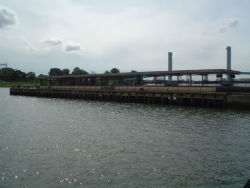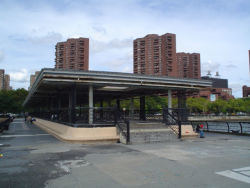Pier 107 CVII
Pier 107
Completed in 1931 by the Department of Docks on a former dump site, the 107th Street pier was built for a markedly different function and neighborhood than it serves today. In the mid-1930s, it was one of seven East River piers between 102nd and 110th Streets, and catered to a teeming industrial district between the waterfront and First Avenue. Warehouses, garages, auto shops, poultry concerns, marble yards, and small factories filled these blocks, which were also home to larger enterprises such as the Harlem Market, located between 102nd and 103rd Streets, the Burns Brothers Coal Company on 107th Street, and the Knickerbocker Ice Company on 108th Street. West of First Avenue, streets were packed solid with five- and six-story tenement buildings.
Construction of the Triborough Bridge, which was completed in 1936, significantly changed the character of the area. The East River Esplanade and the bridge’s approach road obliterated the waterfront stretch of Pleasant Avenue between 107th and 111th Streets, but the Triborough Bridge Authority built a footbridge to allow access to the river and rebuilt the pier for recreational use. Parks organized public activities on the pier soon after it reopened, and continued to do so until the structure began to deteriorate in the 1960s. The pier languished until 1987, when Parks undertook a four-year renovation of the 270-foot-long pier. Joseph Sultan and Giorgio Cavaglieri directed the restoration, which was completed in 1991. The project included the addition of rectangular roof openings for natural illumination and the installation of electric lighting. It won a historic preservation award from the New York State American Institute of Architects.
Nearly all of the waterfront industry on the adjacent blocks of East Harlem has been replaced by large residential developments, including the 1,120-family East River Houses (1941) between 102nd and 105th Streets, and 1199 Plaza (1975), containing 1,500 housing units between 107th and 111th Streets. Visible across the East River are Randalls and Wards Islands, once separate masses that were joined by landfill. Wards Island houses the tall, buff buildings of the Manhattan Psychiatric Center (1954) on its western shore, and most of the island’s 255 acres are parkland, accessible via the Wards Island Pedestrian Bridge (1951) at 101st Street. The relatively humble bridge was designed by Othmar H. Ammann (1879-1965), engineer of many of New York City’s greatest bridges, including the George Washington (1931) and Verrazano-Narrows (1964). Ammann collaborated with Aymar Embury II (1880-1966) on the Triborough Bridge, whose main, gray-colored suspension span may be seen to the east.
Just north of the Triborough is the East River Arch Bridge (1917) of the New York Connecting Railroad -- commonly known as the Hell Gate Bridge -- designed by Gustav Lindenthal (1850-1935) and Henry Hornbostel (1867-1961). Now carrying Amtrak trains to and from the northeast, its massive arch inspired the aesthetics of Australia’s famous Sydney Harbor Bridge. Thousands of diminutive Hell Gates have been installed on model train sets around the world since the bridge’s shrinking, to Lilliputian size, by the Lionel Corporation in 1928.
Check out your park's Vital Signs
Clean & Safe
Green & Resilient
Empowered & Engaged Users
Share your feedback or learn more about how this park is part of a
Vital Park System



